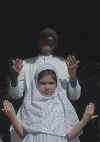|
Visitors:
100 fellow Zarathushtis of Kerman
Date:
11 August 2006
|

|

|

|
| |
|
موبد
يار مهران غيبى، اولين موبدى كه بعد
از 1400 سال در اين آتشكده به نيايش
پرداخت
|
|

|
كليه
عكسها از آقاى حميد صادقى
Photos:
Hamid Sadeghi
darbedar55@gmail.com
www.hamidpix.com |

|
| |
|
|
|

|
|

|
|
Mobedyar Mehran Gheibi, on
the right
|
|
|
|

|

|

|
On 11th August 2006 ((Din rooz of Amordad 3744) , nearly one hundred
of Kerman Zoroastrians visited recently-discovered 1400 years old
ancient Atashkadeh (Fire Temple) of Sassanid era outside the city of
Kerman, Iran. Through a tour conducted by Kerman Cultural Heritage and
Tourism Organization, we prayed there for the first time after Arab's
invasion, as the archeologist explained us. The officials welcomed us
very warmly and entertained us with good breakfast. The recently
discovered Atashkadeh(Fire Temple) is located in hilly land near
mountains, 30-40 kilometers, southwest of Kerman. The nearest (nowadays)
village is Bahramg(j)erd, then Baghin, Kerman City and however a village
with the name of Ghariyat-ol-Arab (=village of arabs).
The archeologist who discovered it, wrote an article and was the first
one who introduced this site to public. He explained many things for
us during our tour that I am trying to summarize them here. The place
was used for keeping sheep and goats by local pastures. The archeologist
that was wandering in the village had heard about it. He discovered it
nearly one year ago and looked for it in books, ancient reports, etc.
There are many evidences that construction of the building is not
complete. The matter that it is constructed far from any people hive,
inhabitant place or populous ness, its undoubted Sassanid elements,...
and its incompleteness shows that in the first decades after Arab
invasion the circumstances was very bad for Zoroastrians, they were not
permitted to have Atashkadeh and do their rituals, etc. Therefore they
went out the city and buld this place. Before completing, the Arabs of
the mentioned Ghariyat-ol-Arab, understood and inhibited/prevented of
its completeness. It is made by natural rubble stone and 'sarooj', upon
a hill.
Mobedyar Mehran Gheibi
Kerman
|









